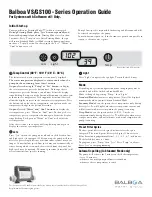
Figure 22.
Fan speed control
Figure 23.
Fan
Figure 24.
Fan belt
In any case, check that the fan rotation
direction matches the direction indicated
by the arrow on the worm-conveyor.
If there is a three-phase electric motor, to
change the direction of rotation simply swap
any two phases of the supply line without
tampering with the wiring of the electrical
panel. It is also necessary to make sure that
the current absorbed by the motor does
not exceed what is indicated on the plate,
adjust—if necessary— the rpm of the fan to
obtain this result.
To adjust the fan speed, proceed as follows:
By increasing the diameter of the drive
pulley, the number of rotations of the fan
and the electric absorption of the motor
increase. The reverse effect will happen if
you decrease the diameter.
Note:
In the case of models equipped with more than
one motor, each motor must be adjusted and its electrical
absorption must be checked
To change rpm of the fan, perform the following
operations:
• Relax the belts tension by unloosing the
screw 1
• Remove the belt 4
• Using an allen key, loosen the screws 2 of
the sheave 3 movable part.
• Rotate the sheave of the movable part until
the desired original diameter is reached.
• Firmly tighten the screws 2
• Install the belt 4 and set to correct tension.
Do not excessively stretch the belts as the
fan shaft could break. When you press the
two sides of the belt with your hands it must
be able to bend about 20-30 mm
FSE 40
The fan motor of the FSE 40 appliance
is keyed directly onto the impeller. The
motor is also available in a three-speed
rotation version. It is shipped from the
factory connected at the minimum speed,
which corresponds to the nominal air flow
without residual useful static pressure; if
it is necessary to increase its performance,
simply connect it to the average or maxi-
mum rotation, respecting the wiring diagram
positioned on the fan itself.
24









































